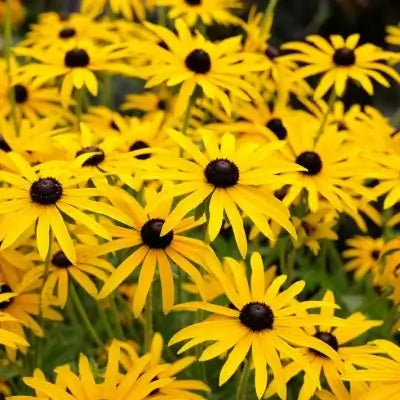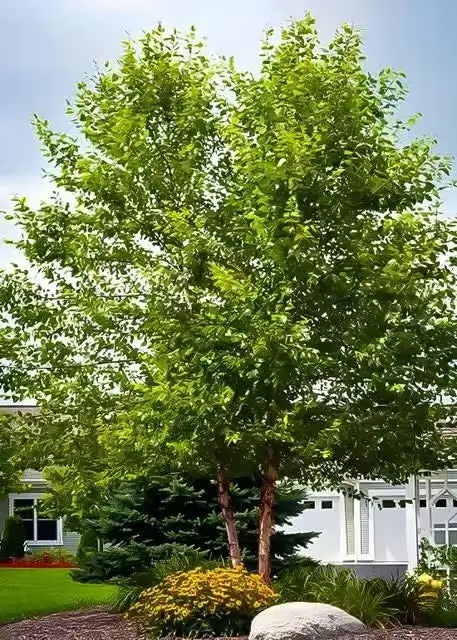
perennial plants
Fast-growing for quick landscape impact
Attractive yellow foliage in autumn
Supports local wildlife with its seeds
Thrives in
ZONE 4ZONE 5ZONE 6ZONE 7ZONE 8ZONE 9Planting Season:
Nov-AprilWhen you add one plant to cart, it automatically adds the second one free on Bogo deals.
The River Birch Tree is a medium-sized deciduous type native to North America. It is prized for its distinctive peeling bark, triangular leaves, and tolerance for wet or poorly drained soils. It is highly valued in landscaping for its aesthetic appeal, adaptability, and numerous benefits. Their unique characteristics and practical advantages make them famous for enhancing outdoor spaces.
It is a deciduous shade-giver with charming, ornamental features for every season. It grows quickly, averaging up to 40 feet tall with a proportionate 30-foot canopy, and it is best known for its vibrant leaves and unusual bark.
It showcases true forest green foliage. Serrated edges give each leaf character; the leaves grow on delicate branches that move easily with the wind. The leaves' alternating arrangement gives them space to flutter, and the combined effect catches the eye in even a light breeze.
In autumn, the green turns to gold. This gorgeous plant puts on a bright show at the end of the growing season. A single plant or small stand can add seasonal color to gardens after the summer flowers have had their turn.
As lovely as its leaves are, this plant's claim to fame is its bark. Contrasting colors pop, and this species' vivid black, white, brown, and salmon bark looks like an Impressionist painting brought to life. The bark naturally peels in papery layers as it grows, creating a shifting display that has enchanted artists and poets for centuries. It's a wonderful trait for gardens and landscape designs. Even without leaves, this plant adds color and visual texture throughout the year.
It has unusual flowers. Instead of petaled blooms in spring, their catkins decorate otherwise bare branches through winter. The catkins grow larger in early spring, and the unusual flowers are relatively discreet. They serve as points of interest for guests and hopeful, seasonal signals that a long, hard winter is ending.
The tree invites nature into any space. It's a great choice for birdwatchers because it attracts hummingbirds and various songbirds. Seeds from fertilized catkins draw many species, and its structure also supports safe nests, so it isn't unusual for chicks to grow up singing in one. Several types of butterflies visit it as well.
They prefer flooded conditions and heavy but well-drained soils. They grow on the River's edge and in wetland forests. They are most comfortable in sunny places with some shade and have no strict requirements for the type of soil - they grow on clay and sand.
These deciduous trees are valued for their attractive cinnamon-colored outer bark. They are also immune to many tree diseases and have a high tolerance for dampness and moisture; for this reason, they can be used for landscaping and soil erosion control.
These are deciduous trees, which are fast-growing and grow to a height of 1.5 to two feet in a year when conditions are perfect for the tree to grow. Soon, they germinate and form a canopy within several years.
The trees normally have expected life spans of 50 to 75 years. Although they may not be as durable as some other species of hardwood, their quick growth and contrasting trunk colors make them ideal for landscape designs.
River birch trees have relatively small root systems that spread to a greater depth, which is why they are used in the prevention of soil erosion. Because these roots can spread quite wide horizontally, they should be planted some distance away from homes, other structures, and underground service lines.

Height at Maturity
Over 25 Feet
Care
River Birch trees thrive in well-drained, moist soil. They need regular watering, particularly during dry years, and mulch the base to keep moisture. They are pruned in late winter to hold the body and remove damaged branches. They are relatively low-maintenance and hardy.
Plant Reproduction
River Birch Tree spreads through wind-dispersed seeds and root sprouts.
Plant bare root trees during the dormant season in early spring or late fall (November through April). Dig the hole twice as wide as the roots so the soil is well-drained. Position the tree so the root flare is at or just above ground level. Fill the hole back with the soil you dug from and water. Maintain soil moisture, especially in the tree's early years, by providing deep, regular watering. Apply a 2-4 inch mulch away from the trunk at the base to retain moisture and suppress weeds. Prune trees during the first few seasons to establish strength and resilience, remove damaged branches, and continue maintenance pruning as the tree matures. Regularly inspect for pests and diseases and apply integrated pest management practices. Protect young trees from mechanical damage and extreme temperatures with tree guards, and stake them if necessary for support, removing the stakes after one or two years.
Shipping date depends on the date displayed and chosen when you order from the product's page.
We only accept returns on plants verified dead. If you think your plants have died, we offer a 1 year warranty, please use use this File a Claim Link to verify dead plants and start with return warranty process.






Distinctive Bark:
The River Birch Tree features striking, peeling bark that adds unique texture and visual interest to any landscape.
Wildlife Friendly:
Attracts birds and other wildlife, providing both beauty and ecological benefits to your garden or yard
Adaptable Growth:
Thrives in a variety of soil conditions, including wet and poorly drained areas, making it a versatile choice for different environments.
Elegant Form:
With its graceful, multi-trunk structure and attractive foliage, the River Birch Tree enhances the aesthetic appeal of any garden.
Caring Tips
Each box contains detailed care instructions and information about your product. But here's the basics.
Care Tips
River Birch trees thrive in well-drained, moist soil. They need regular watering, particularly during dry years, and mulch the base to keep moisture. They are pruned in late winter to hold the body and remove damaged branches. They are relatively low-maintenance and hardy.
Light Requirements
The River Birch Tree grows well in the sun to part shade. It needs at least 4 hours of total sunlight daily. However, it can accept some shade, particularly in hotter climates, making it flexible to various light conditions.
Hardy Planting Zones
4 • 5 • 6 • 7 • 8 • 9
How often should I water my plants?
How do I know if my plant is getting too much or too little sunlight?
What should I do to prepare my plants for winter?
What are the signs that my plant needs fertilizing?
How can I prevent pests from damaging my plants?
How do I choose the right plant for my climate zone?